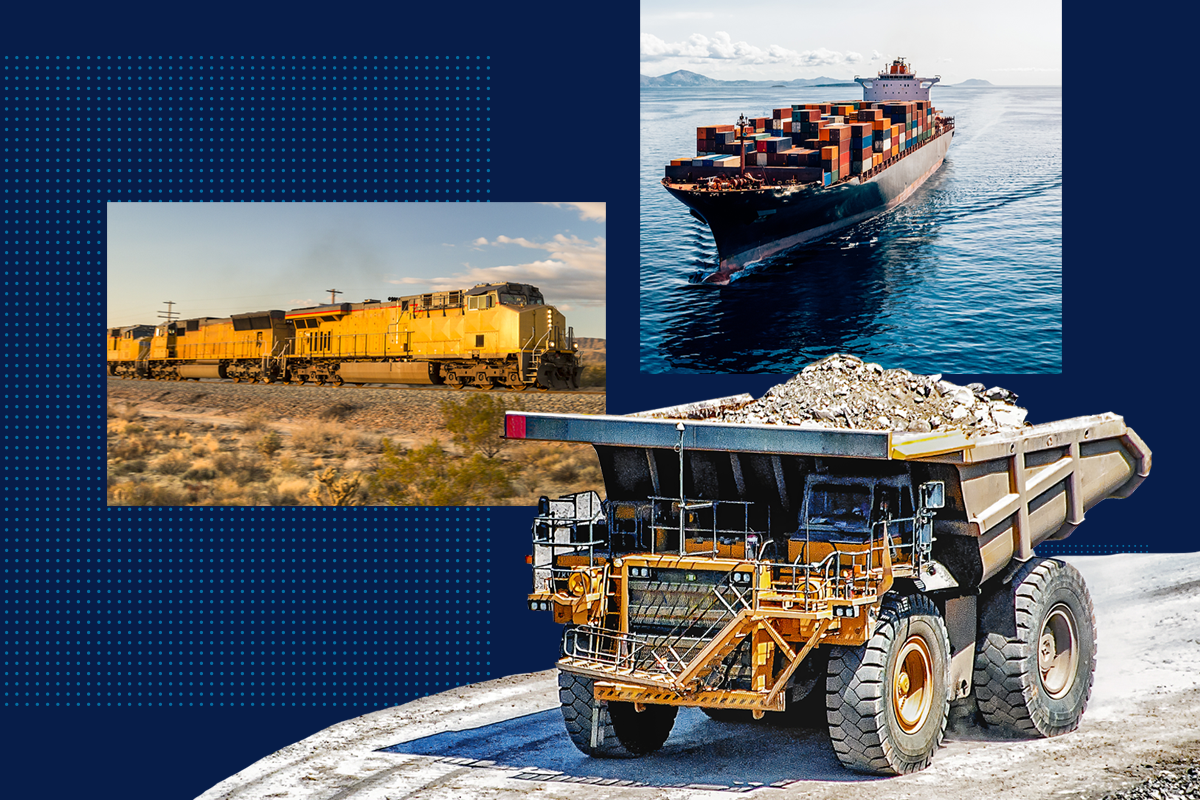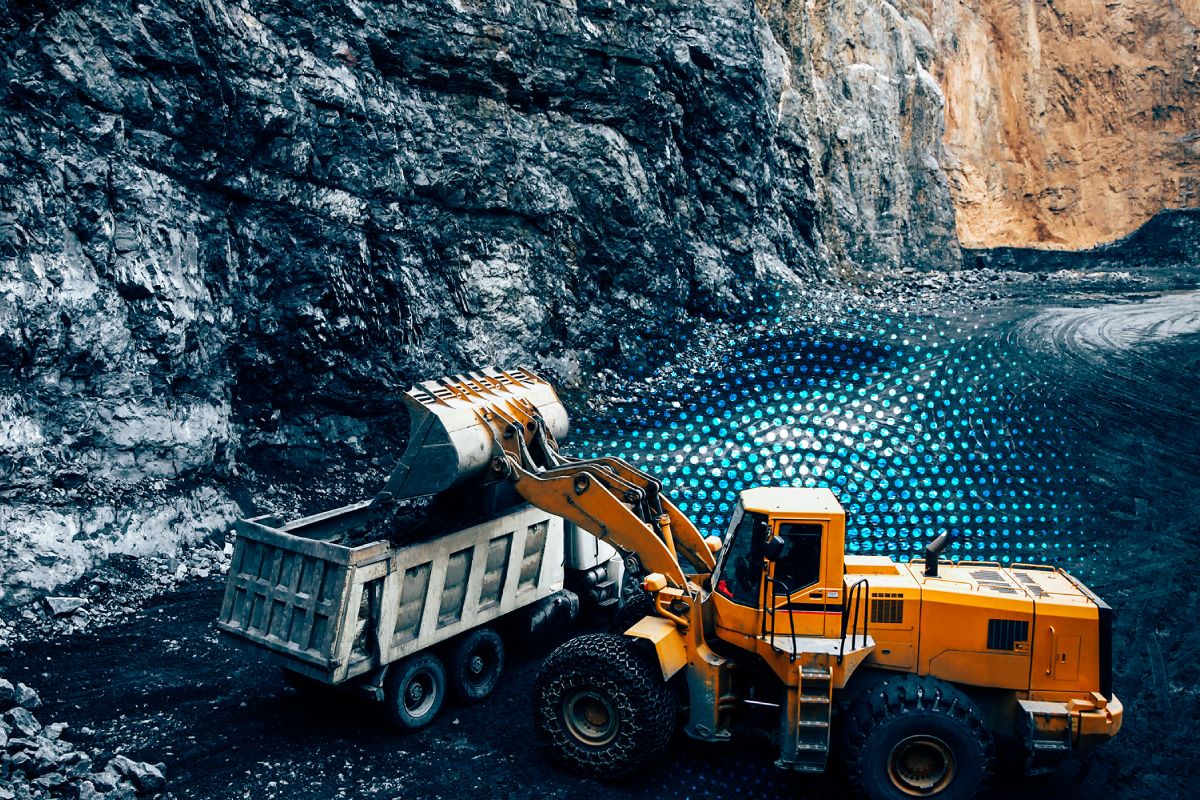How Satellite Powers Communication Across Supply Chains, from Production to Delivery
By Mark Holmes

The era of the smart supply chain is here, as businesses see the value in having visibility across their full supply chains — from raw materials, through production, transportation, and delivery. Full visibility necessitates connectivity, and it’s an opportunity for the satellite industry to supply always-on connectivity to meet these needs.
The entire supply chain of resource production can be united together by satellite connectivity. It starts in the production phase — such as connected tractors on farm harvesting grain, excavators on mining sites using remote control operations, or smart sensors collecting data in the ocean for commercial fishing — all enabled by satellite connectivity.
Products must be shipped via truck, train, or ship, or all of the above to reach their final destinations. Satellite plays a key role in keeping the transport segment connected outside the reach of cellular networks, whether it’s connected freight rail cars, or merchant vessels equipped with satellite terminals. Supply chain visibility is valuable all the way up to delivery to the customer facility, and satellite IoT telematics can provide this visibility into on-road transport.
Satellite connectivity can play multiple roles in these new smart supply chains, says Joel Schroeder, Director of Land Mobile at Intelsat. Operators are looking at the business cases to serve heavy industry customers in a number of ways.
“You need to be addressing the farmer or the mining company. It could be a different company that is operating the vehicles that move that product from the source to production facility. It might be an aftermarket solution. You could have a single end customer that has the need for connectivity for their machines in the field, but then also on the trucks moving their product,” Schroeder says. “This end-to-end type of solution would either need a lot of coordination or a company that is managing those logistics, or it is on us to get access to those customers at different stages in the supply chain.”
Strategic investments into supply chain connectivity are becoming mainstream. According to a Deloitte survey of 182 supply chain leaders, 58 percent are actively using or piloting data-sharing platforms, and 32 percent plan to invest in these solutions in the future. More than half are using or piloting partner connectivity via the cloud as well.
Deloitte’s survey indicated that a critical digital transformation is in motion in the supply chain industry, one that can yield benefits in efficiency, transparency, and resiliency.
Connectivity in Production
Recently, Schroeder witnessed a live demonstration in Japan over a remote-control setup for an excavator at a mining test site. In the demonstration, a person operated the excavator at the mining site from a remote air-conditioned office, through a bank of screens. Mining companies have an interest in these types of solutions, both for safety concerns and workforce reasons. It’s getting harder to find workers who want to live near the remote sites.
“You have fewer risks in the mining pits themselves [with remote operations],” Schroeder says. “But mining companies need high data rates, low latency continuous connectivity, as they are operating these machines in real-time, over the air. This is an interesting use case. It is supply chain production because it is the upstream extraction of the mineral before it moves into the logistics stage of the supply chain. It is an interesting application for satellite.”
Cheaper satellite terminals are part of the equation to reduce the cost of satellite connectivity and make it more feasible for heavy industry sectors, says Gideon Talmor, Vice President of Commercial at hiSky, which manufactures low-cost satellite terminals. The role of the terminal is increasingly important to enable huge cost savings in hardware and capacity prices. He says hiSky’s terminals can lower the price per month of 2 Mbps of Ku-band capacity to just three to five dollars, which is he says is 20 times cheaper than the lowest cost alternative on the market.
Talmor speaks to the benefits for mining customers. Mining companies’ connectivity needs are evolving from just voice channels to Communications on the Move (COTM) and Communications on the Pause (COTP).
“Mining companies can send results in on a much more regular basis from a mining site,” Talmor says. “They may also want to open cameras from time to time. There could be a need to do some low-cost streaming. They don’t want to just open a voice channel.”
Agriculture is another area that can benefit from greater connectivity, as cellular coverage is often lacking in fields. Talmor gives the example of using a satellite terminal for better access to an agriculture machinery support desk.
“We have seen examples where the farmer has had to drive their very expensive big machine, sometimes for hours, to a cellular covered area to get technical support, as they are not in a cellular service area,” he says. “Sometimes, they can find out it is as simple as pressing the wrong button on a machine, but they have wasted time and fuel on getting into a cellular area. This is something [satellite] can help eradicate.”
Farmer Laura Blomme can speak first-hand to the benefit of connected agriculture. Like many in the agriculture sector, Blomme is increasingly using data, often historical data, to improve the efficiency of her supply chain efficiency. She gives an interesting example.
“This year we were in a drought. Thanks to data, we can look back to 2012, when we were in a similar drought, and see how these same farms compare. That gives us an idea about what our yields might be and then we can project better what our yields this harvest will be,” she says. “Connectivity helps us make decisions much more quickly. The better we can make those decisions; we can really fine tune our practices.”
Farmers have a wealth of data available through satellite imagery, and connectivity means they can use this data in real-time. Farmers use data every single day, whether it be looking at satellite imagery to determine crop health and guide decisions when it comes to fungicide application, or how much fertilizer should be applied to a field to meet its nutrient needs.
“It is a whole systems approach. We are gathering information from every single practice that we utilize on our farm, and we use that all together in a one system approach to make the best decisions we can to take care of our resources,” Blomme says. “I think it is really incredible the level of efficiency that the farmer has today. We are all trying to get better every single day at what we do. Connectivity is absolutely critical to what we do and allow us to be better.”

Connectivity in Transport
Products must be transported whether on-road or by rail, or via merchant shipping, and satellite connectivity can give visibility across the journey.
Brazil in particular is an interesting case for connected transport, Intelsat’s Schroeder says. The nation is a top agricultural producer and has a lot of farmlands, much of which has little to no cellular connectivity. While connectivity is valuable in farming, it’s also important during transport of agricultural goods. As one of Latin America’s biggest markets, there is a strong need for connectivity when transporting products/resources. Narrowband solutions historically have been used to provide security because Brazil struggles with road piracy.
“If you are in a country like Brazil, where you may have three to four major [telecommunications] operators, their footprints are not national. There will be a lot of uncovered areas and the pirates will know where those areas are,” Schroeder says. “If a truck gets stopped, you have to make sure they can’t get access to a container. For example, you could cut off the brakes or access to the vehicle.”
Today people want much more data — not just about the location of goods, but also the condition of the goods that are being moved. Truck operators need to have more full-on voice and data connectivity both for security and the future of autonomous trucking, Schroeder says.
Given the quantity of products transported over sea, maritime is another vertical where supply chain communications are absolutely vital. Everyone recognizes that they need to become as efficient as possible, as quickly as possible.
Mike McNally, Director of Maritime Products for Intelsat believes maritime customers are under more pressure than ever before. While digitization may have once ben considered a “nice idea,” it’s become a “requirement for survival” for merchant shipping companies, McNally says.
There are some interesting use cases here, and some are linked to sustainability. McNally talks about how the EU is implementing a border tax for carbon, which will require shipping companies to report how much carbon they are emitting. Failures here could lead to huge fines. There is a need to have smart supply chains with communications in place to provide the authorities with the relevant information.
“You need to be able to monitor this information and clarify the correctness of it in a way that is auditable. In order to do this, you need a continuous real-time connection with a service that can provide that. Our satellite is multi-satellite, multi-beam network. We have over 20 satellites with over 200 beams overlapping each other,” McNally says. “We can’t afford to let a ship go offline if there is a blockage if it is pointing at one of our satellites. That kind of thinking is what is essential to this whole digitization.”
The growth in demand from shipping companies is rising exponentially. Intelsat is seeing strong growth of the number of terminals it services, as well as growth in capacity that each vessel uses. This is across a complete variety of vessels, smaller ones to bigger ones.
“The average use per vessel has gone from 35 Gbps a month to 52 Gbps a month in two years. We have seen a 50 percent increase in the amount of data per ship,” McNally says. “We have also seen a huge increase in the number of ships. We have built that extra capacity into our network and we have built a continuing evolution of that capacity of our network into our next generation because of that. We see that growth curve not slowing.”
By October this year, Intelsat satcom solutions will be on 14,000 vessels. There was a 20 percent increase in the number of vessels it has serviced in the last year. The demands are growing as shipping companies look to significantly improve their supply chains, improving their carbon efficiency, and make sure they use satellite connectivity to monitor everything from individual containers to the overall health of the ship.
McNally remembers sailing past the port of Savannah in 2021 when it was dealing with an ongoing traffic jam that gridlocked the port, and how it connects to the opportunity here.
“I counted 40 ships sitting at anchor off Savannah. What an incredible waste of resources that is,” he says. “Reducing the delays to a minimum is in everyone’s best interest. It reduces the cost of transportation. 80 to 90 percent of all world trade travels over maritime. It is the great bulk of what moves in the world. Making it more efficient is in everyone’s best interest.”
McNally believes the satcoms solutions that we have today are able to handle these kinds of issues when it comes to handling that supply chain. He believes the next layer is the efficiency and the operation of an individual vessel. “When you get to that layer, you are looking at engine monitoring, remote managing of engines and making sure everything is operating properly,” he says.
While containers on ships for example have had connectivity for a long time, the next level of container connectivity is fast approaching, Schroeder says.
“The challenge on the vessel is when you stack the containers, you lose sight of the satellites. You either need something where the satellite devices are forming a mesh network — everything is pushing towards those that have line of sight and are able to communicate to the satellite and the others are tethered to each other when they are stacked on a vessel. Or, you have a localized system on the vessel where it is able to connect sensors through 5G or localized technology on the vessel.”
Staying connected from the first stages of production, all the way through delivery gives businesses much-needed visibility into their entire supply chain. Satellite technology can maintain connectivity regardless of how remote operations are, making full visibility possible.


